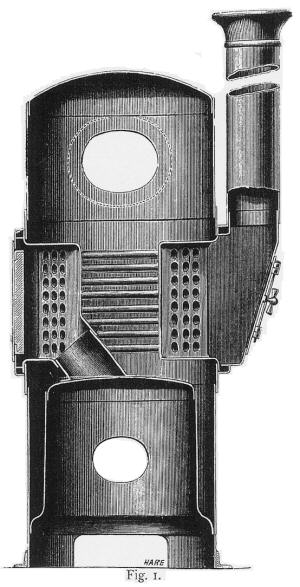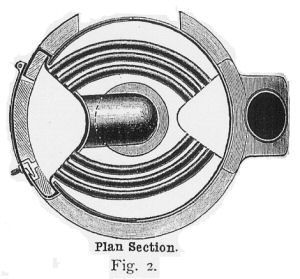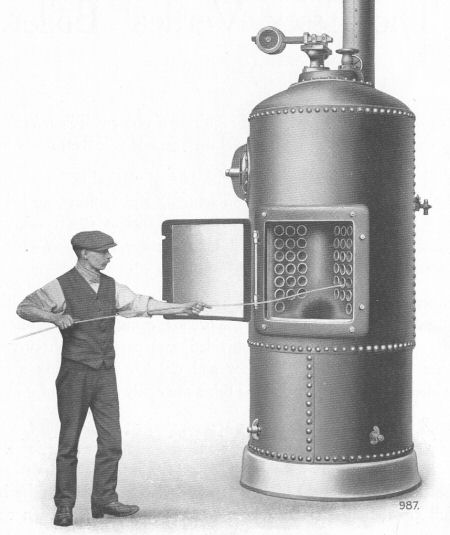Early Paxman Vertical Boilers
The "Essex" Patent and the Improved Cross-Tube
Much of James Paxman's early success in business stemmed from his talent for designing and building efficient boilers. Among the earliest of these were vertical types. Unlike the traditional horizontal shell boiler, the vertical boiler was easy to move about, occupied little space and needed no brick setting. These features made it a useful and popular type.
Only five years after setting up in business, James Paxman exhibited a vertical boiler at the Royal Agricultural Society's Show at Oxford in 1870 where it performed exceptionally well. Subsequently representatives of the technical press were invited to witness an independently controlled test of the boiler at the Colchester Works in October that year. A report in The Engineer commented 'we have not the least hesitation in pronouncing it the best vertical boiler yet produced'. (1)
Paxman's original 'Oxford' boiler had a relatively complicated internal arrangement. Water tubes descended from the top of the firebox, down some distance towards the fire, before turning off to, and being secured in, the sides of the box. This design was phased out during the early 1890s, having been superseded by a basic cross-tube boiler suitable for conditions where water quality was poor and competent stokers were unavailable. The cross-tube boiler sold well, particularly in overseas markets, paired with the Company's Standard Vertical steam engine. At the foot of this page is the text of a late 19th century catalogue description of the Paxman Improved Cross-tube Vertical Boiler.
The Paxman "Essex" Patent Vertical Boiler was a larger, more powerful cross-tube type, launched at the Smithfield Show in the winter of 1885. A more economical and higher quality product, it was designed by James Paxman and the foreman of his boiler shop, Harry Plane. Paxman and Plane secured a joint patent on the design in 1885 and the Essex continued to sell in steady numbers well into the 1930s. (2)
Below are details of the Essex Patent Vertical Boiler and the Improved Cross-Tube Vertical Boiler as shown in a Paxman catalogue believed to have been published in the late 1880s or early 1890s. Under the tables of dimensions in the catalogue are notes that 'Dimensions of larger sizes (are available) on application.'
THE PAXMAN "ESSEX" PATENT VERTICAL BOILER
These Boilers are made in all sizes up to and including 50 Horsepower Nominal.
This new type of Vertical Boiler which Davey, Paxman & Co. have recently patented, and which is here illustrated, is decidedly the best ever introduced.
| Horse- power. | Height. Ft. Ins. | Diameter. Ft. Ins. |
|---|---|---|
| 2 | 5 6 | 2 3 |
| 3 | 6 0 | 2 8 |
| 4 | 6 6 | 2 10 |
| 5 | 7 0 | 3 0 |
| 6 | 7 6 | 3 4 |
| 8 | 8 0 | 3 9 |
| 10 | 8 9 | 4 0 |
| 12 | 9 3 | 4 3 |
| 14 | 9 3 | 4 6 |
| 16 | 10 6 | 4 9 |
| 20 | 11 6 | 5 3 |
| 25 | 12 4 | 5 8 |


It is made entirely of Steel, from 2 Horse-power upwards, and will be found an excellent Boiler for land purposes, as well as for Steam Launches, &c., as it can be made so as to occupy very little space, and at the same time contain a large amount of heating surface.
It will be seen that a straight neck, secured to the top of fire-box, conveys the products of combustion into a chamber to the left. This chamber is of a triangular shape (see Fig. 2), and has an outer flange by which it is riveted to the shell of the Boiler, and to which a door is fitted. An exactly similar chamber is in like manner secured at the right side, with a door and uptake constituting a smoke-box.
These two chambers have a number of tubes of a somewhat semi-circular shape uniting them. The curve of the tubes being of a greater radius than that of the Boiler, enables them to be easily put in or withdrawn.
The Chambers are made of the same fine quality Steel referred to on page 55 (believed to be "a special mild quality of steel, very ductile and easy to weld"). They are formed, while hot in a special hydraulic pressing machine, and are then annealed, so that all the best qualities of the steel are preserved. The shape of the flues causes a centrifugal action in the hot gases, which brings every portion of them into direct contact with the tube surface, so that the highest efficiency is obtained from the heating surface, while, at the same time, full circulation of the water is secured.
These Boilers produce Dry Steam, and as they possess all the essential features of the best types of boilers, they can he strongly recommended. They are, without exception, the best and most economical Vertical Boiler in the market, when Efficiency and Heating Surface are taken into consideration.
The Fittings and Mountings comprise: - Fire-door, Fire-bars, Bearer Ring, Cast-iron Foundation Ring, Combustion Chamber and Door, lined with Fire-brick, Smoke-box Door, 10 feet of Funnel, Gun-metal Water Gauges and Gauge Cocks, Steam-pressure Gauge, Blow-off Cock, Back-pressure Valve, Double Lever and Weight Safety Valves, Fusible Plug, Stop Valve, Man and Mud Holes, with their Covers. One Tube Brush with Flexible Handle, and Spare Gauge Glasses and Collars are also provided free.
Every Boiler is tested to double its working pressure before leaving the Works, and a certificate of test is supplied when required.
Lagging. — when required, these Boilers are lagged with Hair Felt, Wood, and Sheet Iron, or Mahogany, at an extra charge.

Paxman "Essex" Patent Vertical Boiler
IMPROVED CROSS-TUBE VERTICAL BOILERS.
| Horse- power. | Height. Ft. Ins. | Diameter. Ft. Ins. |
|---|---|---|
| 1 | 6 3 | 2 0 |
| 2 | 6 3 | 2 3 |
| 3 | 7 0 | 2 8 |
| 4 | 7 0 | 2 10 |
| 5 | 7 6 | 3 0 |
| 6 | 8 3 | 3 4 |
| 8 | 8 6 | 3 9 |
| 10 | 9 6 | 4 0 |
| 12 | 11 0 | 4 6 |
| 14 | 11 0 | 4 9 |
| 16 | 12 0 | 5 0 |
Davey, Paxman & Co. construct this class of Boiler in all sizes from 1 H.P. TO 25 H.P. Nominal. They are carefully proportioned in order to obtain the greatest amount of heating surface in the least possible space, and to ensure the best results.
Although this type of Boiler is not so economical in the consumption of Fuel as the Patent "Essex" Boiler, described on pages 62 and 63 (text reproduced above), it is preferred in cases where the water is not good, and when competent stokers cannot be had.
The best materials only are used in their manufacture, and every Boiler is tested to double its working pressure.
Unless specially ordered, the Shell is not carried down with an Angle Iron Ring, as shown in the Illustration, but a Cast-iron Foundation Base is supplied for the Boiler to stand on.
The Fittings and Mountings comprise: - Fire-door, Fire-bars, Bearer Ring, Cast-iron Foundation Ring, Gun-metal Water Gauges and Gauge Cocks, Steam Pressure Gauge, Blow-off Cock, Back Pressure or Check Valve, Double Lever and Weight Safety Valves, Fusible Plug, Stop Valve, Manhole, Mudholes and their Covers, and 10 feet of Funnel.
Spare Gauge Glasses and Collars and Spanners are also provided free.
Lagging. — These Boilers are Lagged with Hair Felt, Wood, and Sheet Iron, or Mahogany, when required, at an extra charge.
References:
1. Steam and the Road to Glory, Andrew Phillips, Hervey Benham Charitable Trust 2002 (ISBN 0 9529360 1 1), p.75.
2. ibid p.229
Page updated: 13 APR 2010
